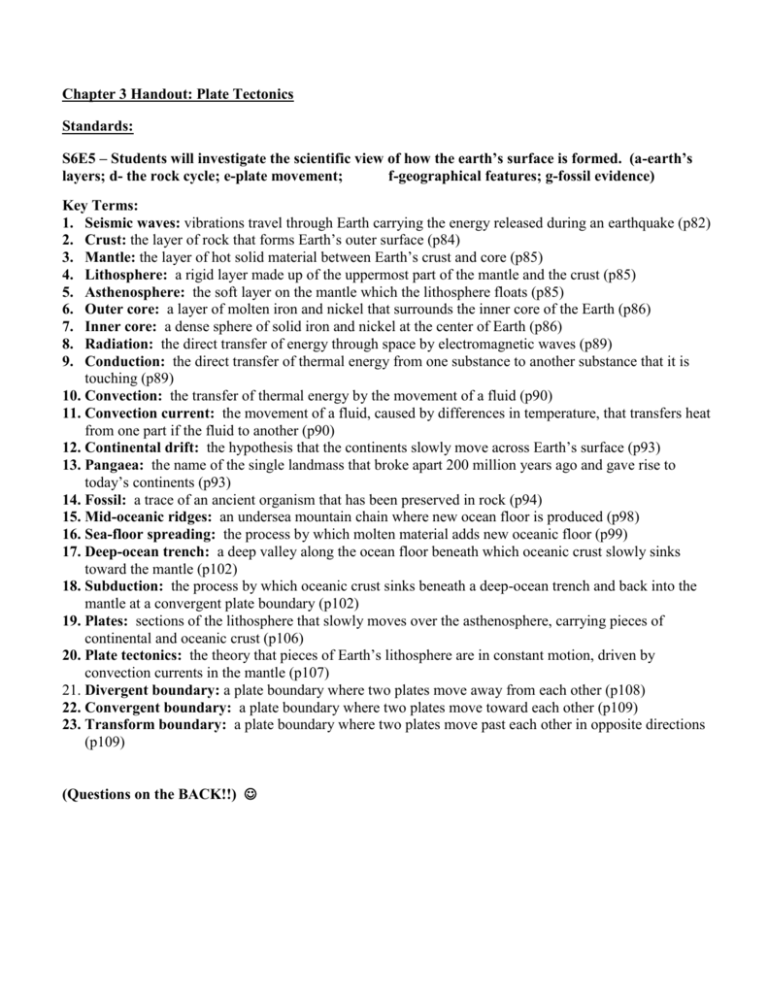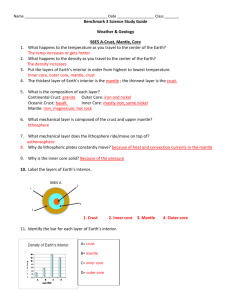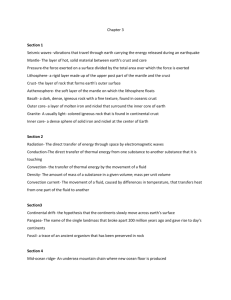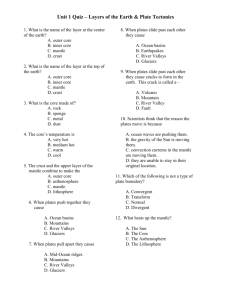File
advertisement

Chapter 3 Handout: Plate Tectonics Standards: S6E5 – Students will investigate the scientific view of how the earth’s surface is formed. (a-earth’s layers; d- the rock cycle; e-plate movement; f-geographical features; g-fossil evidence) Key Terms: 1. Seismic waves: vibrations travel through Earth carrying the energy released during an earthquake (p82) 2. Crust: the layer of rock that forms Earth’s outer surface (p84) 3. Mantle: the layer of hot solid material between Earth’s crust and core (p85) 4. Lithosphere: a rigid layer made up of the uppermost part of the mantle and the crust (p85) 5. Asthenosphere: the soft layer on the mantle which the lithosphere floats (p85) 6. Outer core: a layer of molten iron and nickel that surrounds the inner core of the Earth (p86) 7. Inner core: a dense sphere of solid iron and nickel at the center of Earth (p86) 8. Radiation: the direct transfer of energy through space by electromagnetic waves (p89) 9. Conduction: the direct transfer of thermal energy from one substance to another substance that it is touching (p89) 10. Convection: the transfer of thermal energy by the movement of a fluid (p90) 11. Convection current: the movement of a fluid, caused by differences in temperature, that transfers heat from one part if the fluid to another (p90) 12. Continental drift: the hypothesis that the continents slowly move across Earth’s surface (p93) 13. Pangaea: the name of the single landmass that broke apart 200 million years ago and gave rise to today’s continents (p93) 14. Fossil: a trace of an ancient organism that has been preserved in rock (p94) 15. Mid-oceanic ridges: an undersea mountain chain where new ocean floor is produced (p98) 16. Sea-floor spreading: the process by which molten material adds new oceanic floor (p99) 17. Deep-ocean trench: a deep valley along the ocean floor beneath which oceanic crust slowly sinks toward the mantle (p102) 18. Subduction: the process by which oceanic crust sinks beneath a deep-ocean trench and back into the mantle at a convergent plate boundary (p102) 19. Plates: sections of the lithosphere that slowly moves over the asthenosphere, carrying pieces of continental and oceanic crust (p106) 20. Plate tectonics: the theory that pieces of Earth’s lithosphere are in constant motion, driven by convection currents in the mantle (p107) 21. Divergent boundary: a plate boundary where two plates move away from each other (p108) 22. Convergent boundary: a plate boundary where two plates move toward each other (p109) 23. Transform boundary: a plate boundary where two plates move past each other in opposite directions (p109) (Questions on the BACK!!) Essential Questions: 1. What two types of evidence have geologist used to learn about Earth’s interior? a) direct evidence from rock samples b) indirect evidence from seismic waves (p81) 2. What happens to the temperature as you move toward the center of the earth? To pressure? After 20 meters down, the temperature rises 1° C for every 40 meters. Pressure increases as you go towards the center of the earth. (p83) 3. What are some characteristics of the crust? Layer of solid rock; 5-70km thick; includes soil and water; outer most layer of earth (p84) 4. What are some characteristics of the mantle? very hot, but solid rock; 2867 km thick; 3 layers: lithosphere (upper part of mantle, ridged, about 100 km thick), asthenosphere (below lithosphere, soft), and lower mantle (below asthenosphere, solid) (p85) 5. What are the two parts of the core? outer core and inner core (p86) 6. List the 4 layers of the earth in order starting from the outside. 1) crust; 2) mantle; 3) outer core; 4) inner core (picture p 84) 7. What are the three types of heat transfer? Radiation; conduction; convection (p89) 8. Give an example of heat transfer through radiation. sunlight (p89) 9. Give an example of heat transfer through conduction. a spoon touching the side of a pot (p89) 10. Give an example of heat transfer through convection. soup heating up in a pot (p90) 11. What sets convection currents in motion? Heating/cooling of fluid, changes in fluid density, and force of gravity (90) 12. What causes convection currents in the mantle? heat from the core and the mantle itself causes currents in the mantle (p91) 13. What was Wegener’s hypothesis called and what does it state? Wegener’s hypothesis is called “continental drift”; states that all the continents were once joined together in a single landmass and have slowly drifted apart over the millions of years (p93) 14. How did Wegener come up with this hypothesis? gathered evidence from different scientific fields to support ideas; studied land features, fossils, and evidence of climate change (p93) 15. What device is used to map the ocean floor? sonar (p98) 16. Explain sea-floor spreading (hint: pg 99). The sea floor spreads apart along both sides of a midoceanic ridge as new crust is added. 17. How does new oceanic crust form? Molten material rises and erupts into the space left by the sea floor spreading, then cools. As it cools, it forms a strip of solid rock in the center of the ridge. (p99) 18. What is the evidence that supports the theory of sea-floor spreading? The evidence is from molten material, magnetic stripes, and drilling samples. (p100-101) 19. Where would you expect to find the oldest rock on the ocean floor? farther away from the ridges, away from the centers (p101) 20. What occurs at ocean trenches? Part of the ocean floor sinks back into the mantle at deep-ocean trenches. (p102) 21. What is the theory of plate tectonics? It explains the formation, movement, and subduction of Earth’s plates. (p107) 22. What do scientists think cause the movement of Earth’s plates? They think that the movement of convection currents in the mantle causes plate motion. (p107) 23. What are the three types of plate boundaries? divergent (pull apart); convergent (come together and one plate goes below the other); transform (slides past each other) (p109) 24. What features form at divergent boundaries? mid-ocean ridges & rift valleys (p108) 25. What features form at convergent boundaries? mountain ranges and trenches (p109) 26. What features form at transform boundaries? earthquakes occur, but nothing is created (p109) Chapter 3 Study Guide Alfred Wegner developed the hypothesis of continental drift. This hypothesis states that all continents were once joined as a single supercontinent (Pangaea) and have since drifted apart. Evidence to support continental drift includes landforms, fossils, and climate. The earth’s lithosphere is broken into plates. According to the theory of plate tectonics, these plates are in constant, slow motion driven by convection currents in the Earth’s mantle. Continental plates carry the continents (land). Oceanic plates carry the seafloor. There are three types of plate boundaries: 1. Convergent Boundaries – a place where two plates come together (converge). continental plate and continental plate – mountains are formed (crust is created) oceanic plate and oceanic plate OR continental plate and oceanic plate – the more dense plate (one of the oceanic ones) sinks under the other one (less dense oceanic plate or continental plate). This process happens at deep ocean trenches and is called subduction. During subduction, crust is destroyed (or recycled). 2. Divergent Boundaries – a place where two plates move apart (diverge) oceanic plate and oceanic plate – new seafloor is formed from molten material rising from the mantle and erupting at mid-ocean ridges. Mid-ocean ridges are found in all of Earth’s oceans. As the new seafloor is formed, the older seafloor is pushed outward from the ridge (seafloor spreading). Scientists discovered that rocks farther away from the mid-ocean ridge were older than those near it by determining the age of rock samples obtained by drilling on the sea floor. Continental plate and continental plate – a deep valley called a rift valley is formed. 3. Transform Boundaries – a place where two plate slip past each other. Earthquakes often occur along transform boundaries, but crust is not created or destroyed.









